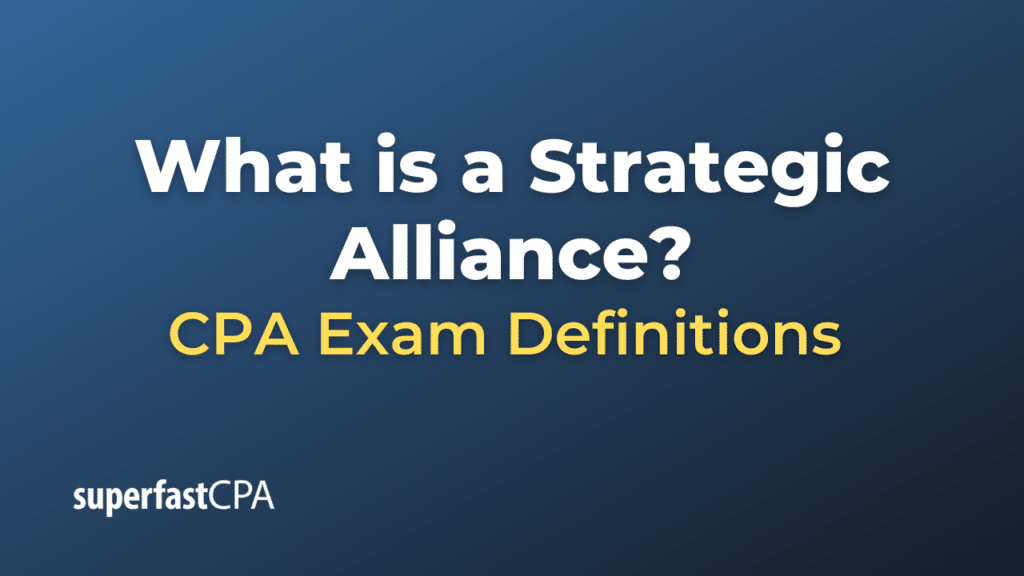Strategic Alliance
A strategic alliance is a formal arrangement between two or more companies to pursue a set of agreed upon objectives while remaining independent organizations. It’s a cooperative agreement that often allows companies to share resources, capabilities, and competencies in order to gain a competitive advantage or achieve a shared goal. Strategic alliances can take various forms, including joint ventures, partnerships, equity alliances (where one company acquires a partial equity stake in the other), or non-equity alliances (purely contractual relationships without shared ownership).
The primary reasons companies enter into strategic alliances include:
- Access to new markets or regions: By partnering with a local entity, a company can quickly gain a foothold in a new geographic market.
- Sharing of resources and expertise: Companies might collaborate to share research and development (R&D) costs or to access each other’s technological expertise.
- Risk and cost sharing: Collaborative efforts, especially in capital-intensive sectors, help distribute risks and reduce individual costs.
- Enhancing operational efficiencies: By sharing infrastructures or administrative functions, partners can achieve economies of scale.
- Access to new customers or distribution networks: A partnership might open up new sales channels or customer segments.
- Product or service diversification: Companies can expand their product or service lines by leveraging a partner’s offerings.
- Navigating regulatory environments: In some industries or countries, regulatory constraints might necessitate partnerships or joint ventures.
Example of a Strategic Alliance
Let’s delve into a specific example of a strategic alliance between two major companies: Sony and Ericsson.
Strategic Alliance between Sony and Ericsson
Background: In the early 2000s, both Sony and Ericsson faced challenges in the mobile phone market. Sony, known for its consumer electronics expertise, lacked a significant presence in the mobile phone sector. Ericsson, on the other hand, had telecommunications expertise but faced stiff competition and financial pressures. Both companies saw an opportunity to leverage each other’s strengths.
Formation: In 2001, Sony and Ericsson formed a joint venture, combining their mobile phone businesses to create Sony Ericsson. The objective was to merge Sony’s strengths in consumer electronics (like audio and video technologies) with Ericsson’s knowledge of telecommunications technology.
Benefits:
- Shared Resources : The partnership allowed both companies to pool their resources, R&D capabilities, and technological assets.
- Market Expansion: Ericsson gained access to markets where Sony had a strong presence, and vice versa.
- Innovative Products: Sony Ericsson introduced unique products that combined features of Sony’s Walkman and Cyber-shot series with mobile phones, leading to iconic products such as the Walkman phone and the Cyber-shot phone.
- Risk Mitigation : By joining forces, both companies could share the risks associated with the competitive and rapidly evolving mobile phone market.
Outcome: The partnership lasted for over a decade, during which Sony Ericsson produced several successful mobile phone models. However, as the market transitioned towards smartphones and competition from companies like Apple and Samsung intensified, Sony Ericsson faced challenges. In 2012, Sony acquired Ericsson’s stake in the joint venture, and Sony Ericsson became a wholly-owned subsidiary of Sony, eventually rebranded as Sony Mobile.
This strategic alliance showcases how two companies, each with its own set of strengths, can come together to address market challenges and leverage combined capabilities. While the long-term market dynamics shifted with the advent of smartphones, the alliance allowed both Sony and Ericsson to remain competitive and innovate during a pivotal period in the mobile phone industry.













